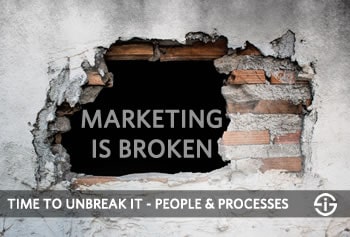
Despite the variety of topics, tactics and speakers, our 2012 Fusion Marketing Experience conference clearly revolved around one theme: marketing is broken. We are disconnected from our customers and other departments. The word that was most often mentioned: silos. The number one debated topic among the speakers during and after the event: organizational challenges.
It was interesting to see how the seeds of new views were planted and customer-centricity is being ‘rediscovered’ from different angles. The organization as a living being. The holistic and biological view. The reasons why our organizations are sick. So what’s causing our organizations to be ill? I think you might hear about that later from a friend.
However, I’m a marketer and that’s what concerns me most: what do marketers need in order to reconnect with customers and are not looked upon as liars and, within the organization, as excess luggage?
Does anyone love the marketing department in your organization? As Kristin Zhivago said, ‘marcom’ has become a dirty word.
People decreasingly want to be sold to. What’s going to happen to sales? What’s the role of marketing today? How can marketers prove that they really matter a lot? How can we fix the fact that marketing is broken? Below are the two key P’s of broken marketing and at the same time to fix just that.
Marketing success and a message to the CEO
However, first consider this:
In order to be successful, marketers have three key ‘audiences’: (prospective) customers, other divisions and the CEO.
- It’s the role of the CEO to make sure the business grows. To convince the CEO, marketers need to be accountable, measure and prove ROI. Marketers need to be able to demonstrate profit as a consequence of being out there, listening at what customers want and aligning these needs with the business goals.
- In order to reconnect with the customer, provide value and regain trust, marketers need to be customer-centric, without any compromises. It means standing up against bad decisions from a customer viewpoint and continuously demonstrating that it’s the only thing that actually works.
- In order to regain its’ very reason of existence, marketing can take the lead in changing the organization from within. Here is a fact: since most of the time no one has the courage to do it, it’s an opportunity for marketers to stick out their necks and drive collaboration, being the guardian angels of the customer and making sure the customer is served before, during and after the buy: end-to-end and beyond the silos.
Finally, a word for the CEO: if you cut on budgets to train and empower your marketing teams to be more data-driven, customer-centric and in tune with a changing market, and if you don’t invest in the right people to be able to plan, execute and follow-up well, you bear a huge responsibility too. Your customer is in control. It’s your job, as a CEO, to make sure your organization is ready to embrace that reality instead of rejecting it.
Two P’s to ‘unbreak’ your marketing
Where is marketing broken? If you know, you also know how to fix it.
People
We left people out of the marketing equation. We called them targets and got stuck in war rhetoric, increasingly leading to alienation and a customer disconnect. We forgot to listen, care and deliver. We hid behind dashboards and forgot to simply ask the questions that matter. We also left out the people that are most involved with the ecosystem of our brand: our employees. We invest in quick wins and fight over market share with our competitors. However, we do not follow up on the promises we make and stop caring after – and even before – the buy. We don’t stand out and ignore the fact we need more than tools and tactics. We need people in our marketing teams that help us defend our interests by defending those of our customers. We don’t have the human resources to care, persuade and continue the relationship. We don’t have the people to build the bridges we have burnt, internally and externally. And if we have them, we don’t support them as we should.
Processes
We have automated. We use platforms and technologies. However, the majority of the technologies we buy is sitting there, underused. We have no people to properly use them and lack the processes to actually get results out of them that can be followed up and shared across our silos. We have no processes to gain knowledge and insights. We prefer to outsource everything because we do not want to admit we are clueless in a social world. We prefer to hand over responsability to someone else. We pay for strategies and advice from people that don’t even understand our businesses. And when the expensive strategies are there, we realize we forgot we needed processes and people to make them happen.
Ask yourself: what percentage of your marketing and customer technologies do you actually use? What processes do you have to serve your customers in a consistent way? What processes do you have to measure, report and prove to the C-suite that what you do as a marketer actually matters?
These are the two main reasons why marketing is broken. But there are more, stay tuned. What other reasons do you see, whether they start with a P or not? And what will you do about them?
Top image purchased under license from Shutterstock

